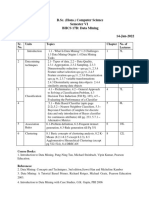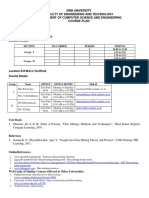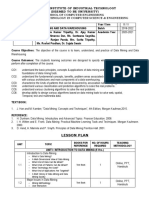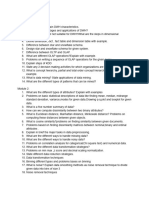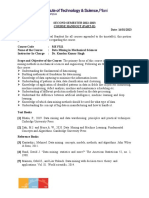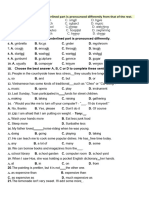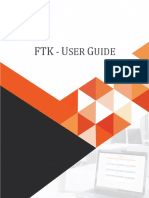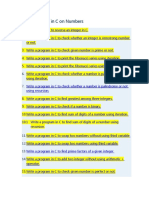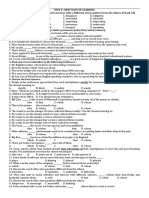Guidelines of DSE Semester V (NEP UGCF 2022)
Data Mining for Knowledge Discovery
(Effective from Academic Year 2024-25)
Sr. Units Chapter Reference No. of
No. Hours
1 Unit 1 Introduction 1.1-1.4, 2.4.2, 2.4.3 [1] 6
(excluding properties)
Need for data mining, Data mining tasks,
Applications of data mining, Measures
of similarity and dissimilarity, Supervised vs.
unsupervised techniques.
2 Unit 2 Data collection and preparation 2.1,2.2, 2.3.1, 2.3.2, 2.3.3 [1] 8
(introduction), 2.3.4
Measurement and data collection issues, Data (introduction), 2.3.5
aggregation, Sampling, Dimensionality (introduction), 2.3.6
reduction, Feature subset selection, Feature (Binarization and
creation, Discretization and binarization, Discretization of Continuous
Variable transformation.. attributes), 2.3.7
3 Unit 3 Clustering data (14 Hours) 5.2 (5.2.1-upto Data in [1] 14
Euclidean Space, 5.2.5), 5.3
Basic concepts of clustering, Partitioning (5.3.1, 5.3.2-Excluding
Methods: K-means algorithm, Hierarchical Ward’s and Centroid
Methods: Agglomerative Hierarchical methods, 5.3.6), 5.4,
Clustering, Density-Based Methods: DBSCAN 5.5(5.5.1,5.5.5,5.5.7)
Algorithm, Strengths and weaknesses of
different methods, Cluster evaluation.
4 Unit 4 Classification 3 (up to 3.3.3), 3.4 [1] 10
(introduction) 3.6, 6.3, 6.4,
Preliminaries, Naive Bayes classifier, Nearest 6.7 (introduction),
Neighbour classifier, Decision tree, Artificial 6.11(introduction, 6.11.2)
Neural Network, overfitting, Confusion matrix,
Evaluation metrics and Model evaluation.
5 6.10 (Excluding 6.10.3) [1] 7
Unit 5 Ensemble Methods
Need for ensembles, Random Forest, Concept
of Bagging and Boosting in ensembles.
.
Text Book:
� 1. Tan P.N., Steinbach M, Karpatne A. and Kumar V. Introduction to Data Mining,
Second edition, Sixth Impression, Pearson, 2023.
Additional References:
1. Han J., Kamber M. and Pei J. Data Mining: Concepts and Techniques, 3 edition, rd
2011,
Morgan Kaufmann Publishers.
2. Zaki M. J. and Meira J. Jr. Data Mining and Machine Learning: Fundamental Concepts
and Algorithms, 2 edition, Cambridge University Press, 2020.
nd
3. Aggarwal C. C. Data Mining: The Textbook, Springer, 2015
4. Dunham M. Data Mining: Introductory and Advanced Topics, Pearson, 2006.
For practicals, datasets may be downloaded from :
1. https://archive.ics.uci.edu/datasets
2. https://www.kaggle.com/datasets?fileType=csv
3. https://data.gov.in/
4. https://ieee-dataport.org/datasets
5. Time Series Datasets (kaggle.com)
Suggested Practical Exercises
1. Apply data cleaning techniques on any dataset (e.g. Chronic Kidney Disease dataset from
UCI repository). Techniques may include handling missing values, outliers and inconsistent
values. Also, a set of validation rules may be specified for the particular dataset and validation
checks performed.
2. Apply data pre-processing techniques such as standardization/normalization,
transformation, aggregation, discretization/binarization, sampling etc. on any dataset
3. Apply simple K-means algorithm for clustering any dataset. Compare the performance
of clusters by varying the algorithm parameters. For a given set of parameters, plot a
line graph depicting MSE obtained after each iteration.
4. Perform partitioning, hierarchical, and density-based clustering algorithms on a
downloaded dataset and evaluate the cluster quality by changing the algorithm's
parameters.
5. Use Naive bayes, K-nearest, and Decision tree classification algorithms to build
classifiers on any two datasets. Pre-process the datasets using techniques specified in
Q2. Compare the Accuracy, Precision, Recall and F1 measure reported for each dataset
using the abovementioned classifiers under the following situations:
i. Using Holdout method (Random sampling):
a) Training set = 80% Test set = 20%
b) Training set = 66.6% (2/3rd of total), Test set = 33.3%
ii. Using Cross-Validation:
a) 10-fold
b) 5-fold
� 6. Use the Decision Tree classification algorithm to construct a classifier on two datasets.
Evaluate the classifier's performance by performing ten-fold cross validation. Compare
the performance with that of:
i. Bagging ensemble consisting of 3, 5, 7, 9 Decision tree classifiers
ii. Adaboost ensemble consisting of 3, 5, 7, 9 Decision tree classifiers
Project: Students should be promoted to take up one project on using dataset downloaded
from any of the websites given above and the dataset verified by the teacher. Preprocessing
steps and at least one data mining technique should be shown on the selected dataset. This
will allow the students to have a practical knowledge of how to apply the various skills learnt
in the subject for a single problem/project.







